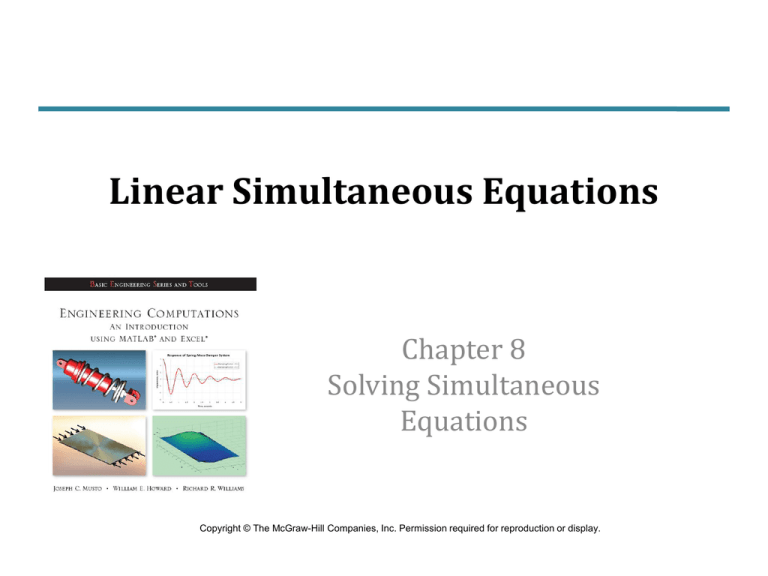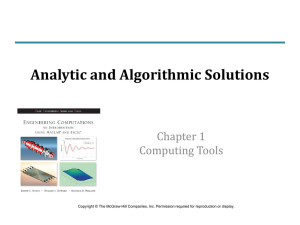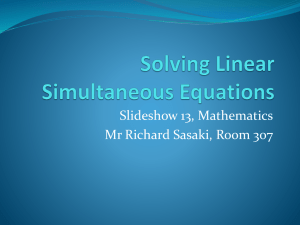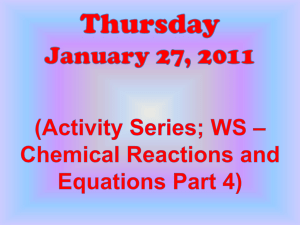Linear Equations
advertisement

Linear Simultaneous Equations Chapter 8 Solving Simultaneous Equations Copyright © The McGraw-Hill Companies, Inc. Permission required for reproduction or display. Review: Linear Simultaneous Equations • If equations contain only linear terms of the independent variables – that is, only constants multiplied by each variable – and constants, then the equation is linear • If the equation contains any terms such as x2, cos(x), ex, etc., then the equation is non-linear • Consider these two linear equations: Engineering Computation: An Introduction Using MATLAB and Excel Solution to Simultaneous Equations • Are there values of x and y that fit both equations? • That is, are there values of x and y that simultaneously satisfy both equations? • For two equations, it is easy to find the solution by substitution: • Write the second equation as: Engineering Computation: An Introduction Using MATLAB and Excel Solution by Substitution • Substitute the second equation into the first: • Solve for x: • Substitute x into the second equation: Engineering Computation: An Introduction Using MATLAB and Excel Graphical Solution • For equations with two variables, a graphical solution is possible • For each equation, plot two points to define a line • If the lines intersect, then the intersection point is a solution to both equations Engineering Computation: An Introduction Using MATLAB and Excel Graphical Solution Equation 1 Equation 2 Engineering Computation: An Introduction Using MATLAB and Excel Review: Equations in Matrix Form • The first step in using matrix methods to solve a series of linear simultaneous equations is to write them in matrix form • For n simultaneous equations and n unknowns: where A is the coefficient matrix (n × n); X is the matrix of unknowns (n × 1), and C is the constant matrix (n × 1) Engineering Computation: An Introduction Using MATLAB and Excel Review: Linear Simultaneous Equations • Recall that if there are more unknowns then equations, then we cannot find a unique solution • If there are more equations than unknowns, then some equations must be redundant • If there are exactly the same number of equations and unknowns, then there may be a unique solution. In this case the coefficient matrix will be square Engineering Computation: An Introduction Using MATLAB and Excel Solution of System of Linear Equations • Multiply both sides of the equation by the inverse of the coefficient matrix. Remember that the order of multiplication is important. • Since the inverse of a matrix times that matrix is equal to the identity matrix, Engineering Computation: An Introduction Using MATLAB and Excel Solution of System of Linear Equations • Since the identity matrix times another matrix is equal to that matrix, • Therefore, we can find the unknown variables by multiplying the inverse of the coefficient matrix by the constant matrix Engineering Computation: An Introduction Using MATLAB and Excel Example – 2 Equations • Let’s use the matrix approach to solve the equations of the earlier example: • The first step is to write the equations in matrix form: Engineering Computation: An Introduction Using MATLAB and Excel Example – 2 Equations • Next, we need to find the inverse of the A matrix: Engineering Computation: An Introduction Using MATLAB and Excel Example – 2 Equations • To find x and y, multiply the inverse of A by C: Engineering Computation: An Introduction Using MATLAB and Excel MATLAB Solution >> A = [2 3;-4 1]; >> C = [14;28]; >> X = inv(A)*C X = -5 8 >> Engineering Computation: An Introduction Using MATLAB and Excel Another Example • Consider these two equations: • MATLAB: >> A = [2 3;4 6]; >> C = [14;28]; >> X = inv(A)*C Warning: Matrix is singular to working precision. X = Inf Inf Engineering Computation: An Introduction Using MATLAB and Excel What’s Wrong? • Solve with substitution: • Second equation in terms of y: • Substitute into first equation: Engineering Computation: An Introduction Using MATLAB and Excel What’s Wrong? • Solve: • Any value of x will satisfy this equation Engineering Computation: An Introduction Using MATLAB and Excel Graphical Solution Engineering Computation: An Introduction Using MATLAB and Excel Interpretation of Solution • The second equation is equal to the first equation multiplied by a constant • Therefore, both equations are the same, as noted by the fact that they define the same line • Any point on the line will satisfy both equations • Therefore, there are an infinite number of solutions to these equations Engineering Computation: An Introduction Using MATLAB and Excel A Third Example • Consider these two equations: • MATLAB: >> A = [2 3;4 6]; >> C = [12;28]; >> X = inv(A)*C Warning: Matrix is singular to working precision. X = Inf Inf Engineering Computation: An Introduction Using MATLAB and Excel What’s Wrong? • Solve with substitution: • Second equation in terms of y: • Substitute into first equation: Engineering Computation: An Introduction Using MATLAB and Excel What’s Wrong? • Solve: • No value of x will satisfy this equation Engineering Computation: An Introduction Using MATLAB and Excel Graphical Solution Engineering Computation: An Introduction Using MATLAB and Excel Interpretation of Solution • The graphical solution shows that the two equations define parallel lines • Since parallel lines never intersect, there is no point that satisfies both equations • Therefore, there is no solution to these equations • Note that MATLAB (or Excel) solution will result in the same error – the inverse of the coefficient matrix does not exist Engineering Computation: An Introduction Using MATLAB and Excel Summary • If the inverse of the coefficient matrix exists, then there is a solution, and that solution is unique • If the inverse does not exist, then there are two possibilities: – The equations are incompatible, and so there are no solutions, or – At least two of the equations are redundant, and so there are more unknowns than unique equations. Therefore, there are an infinite number of solutions Engineering Computation: An Introduction Using MATLAB and Excel Example – 3 Equations • Write these equations in matrix form: Engineering Computation: An Introduction Using MATLAB and Excel Example – 3 Equations • MATLAB solution: >> A = [12 32 -10; 0 2 3; 7 16 5]; >> C = [-30; 11; 42]; >> X = inv(A)*C X = 7.0000 -2.0000 5.0000 >> Engineering Computation: An Introduction Using MATLAB and Excel Excel Solution • Enter coefficient and constant matrices: Engineering Computation: An Introduction Using MATLAB and Excel Excel Solution • Label and highlight cells for matrix of unknown variables: Engineering Computation: An Introduction Using MATLAB and Excel Excel Solution • Enter formula to invert A matrix and multiply the result by the C matrix. This can be done in two steps or with nested commands as shown here: Engineering Computation: An Introduction Using MATLAB and Excel Excel Solution • Apply formula to the selected array of cells by pressing Ctrl + Shift + Enter: Engineering Computation: An Introduction Using MATLAB and Excel







